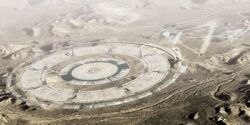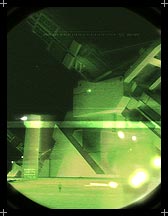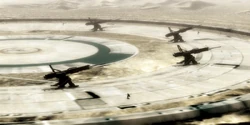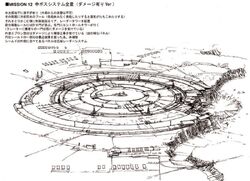The Stonehenge Turret Network, more commonly referred to as Stonehenge, was a planetary defense complex created by the Federation of Central Usea in western Usea. It was one of the primary weapons developed at the end of the 20th century to address the threat of the Ulysses 1994XF04 asteroid.
Stonehenge was captured by the former Federal Republic of Erusea in 2003, causing other Usean countries to form the Independent State Allied Forces and declare war. Erusea utilized Stonehenge to shoot down ISAF pilots through the majority of the war, but the facility was eventually destroyed by Mobius 1.
History
Creation

After the discovery of Ulysses in late 1994 and the determination of its trajectory, news of the impending impact was kept secret in order to avoid widespread panic. Finally, on April 20, 1996, FCU President Robert Sinclair disclosed the existence of the asteroid to the world in a public news conference.[1] That same day, FCU Secretary of State Stetson held a second, private conference at an emergency assembly of the Central Usea Treaty Organization (UTO), where various defense proposals were made, including the creation of a "National Missile Defense" system within UTO member nations.[2]
The Stonehenge complex—known internally as Project STN[3] (Spaceguard Turret Network[4])—was later conceived by the FCU under the Defense Initiative plan. Construction took place in Area 26021-3, a site in the desert region south of San Salvacion. The weapon's development was overseen by the Project STN Committee and security was provided by UTO coalition troops and a fighter squadron, whose roster included John Herbert, a veteran of the Usean Continental War.[5]

Construction crews assembling Stonehenge
Numerous governments, corporations, and scientists from around the world participated in the construction effort; at least one Belkan scientist, David Hartmann, was known to have been involved.[6] Osea and Yuktobania initially considered joining the project, but declined on account of post-Belkan War reconstruction efforts.[7][8] The main STN site was completed in June 1998, while the rest of the railgun system remained under construction for several more months.[9]
In the same month, the International Union of Astronomists released an updated report on Ulysses' projected impact area, sparking protests in Anea against the FCU over the northern hemisphere's lack of protection against the asteroid. By that time, however, Stonehenge had reached a point in its development where no further modifications could be made.[10]
Ulysses Day and Erusian takeover

A group of soldiers watching Ulysses' approach from Stonehenge
On July 3, 1999, Stonehenge went online and commenced operations against Ulysses, successfully limiting damage across the Usean continent during the planetfall event.[11] Although it was one of the most successful weapons of its type during the disaster, one of Stonehenge's eight railgun cannons was disabled by a meteorite impact and remained out of commission for the rest of its existence.[12]
In the aftermath of Ulysses Day, Erusea was overwhelmed by an influx of refugees, compelling Erusian officals to close the nation's boarders.[13] As tensions escalated with the international community, the Erusian military, without warning, invaded San Salvacion in the summer of 2003 and captured Stonehenge. The weapon's capture, together with the invasion of San Salvacion, caused great worry within the international community. In an official statement, Erusea declared that STN ground patrols and staff were being kept "under protection" by its troops; twelve UTO aircraft disappeared during the incident.[14]
On August 22, 2003, Erusea sent an ultimatum to Robert Sinclair, threatening attacks against the Federation and its allies if he refused to order the withdrawal of FCU forces from San Salvacion's borders before September 9.[7] Sinclair responded by threatening to declare war if the occupation troops in both San Salvacion and Stonehenge were not removed before September 14.[15] The standoff led to the formation of the Independent State Allied Forces, which dispatched an elite squadron to perform a surprise attack on Stonehenge on September 14; the effort, however, was soundly defeated by the Federal Erusea Air Force's infamous Yellow Squadron.[7][16]
Second Usean Continental War

A reconnaissance photo of a Stonehenge railgun turret
After ISAF's retreat from the mainland, and the relocation of its headquarters to North Point, the ISAF began making retaliatory strikes in preparation for a counterattack. Shortly after the capture of Stonehenge, the Erusian government announced its plan to produce X-02 Wyverns to serve as the superweapon's protectors, sparking debate within the Erusian Parliament over their cost and efficacy, which eventually halted the X-02's production.[7]
During the ISAF's counteroffensive operations within mainland Usea, Erusea used Stonehenge to attack the ISAF with limited success. In March 2005, several engineers and scientists responsible for designing the weapon, who had been detained by Erusea under the pretext of "security purposes", escaped with their families on-board Air Ixiom Flights 701 and 702. In exchange for protection and amnesty, the engineers offered to provide ISAF with crucial information regarding Stonehenge's defensive systems. ISAF ace Mobius 1 was dispatched to escort and defend the airliners from Erusian fighters until their safe arrival within ISAF territory.[17][7]

The Stonehenge railgun turrets ready to fire
A month later, on April 2, the ISAF launched a second aerial attack on Stonehenge. The effort, codenamed Operation Stone Crusher, resulted in the complete destruction of the facility and its railguns due to Mobius 1's intervention. Yellow Squadron scrambled from nearby San Salvacion to intercept the ISAF squadrons, but were forced to retreat after Mobius 1 shot down Yellow 4.[7][12]
Design
One of humanity's foremost projects built to combat the threat of Ulysses, Stonehenge was based on a circular design divided into eight sections, each of which housed a railgun turret.[9] The weapons, officially called the "120cm dual-use anti-air-and-surface, gunpowder-and-electromagnetic hybrid acceleration system, semi-automatic fixed guns", operated on a hybrid energy principle using gunpowder to initially propel projectile shells, and then accelerate them to maximum velocity with electromagnetic energy.[18]
The cannons were considered "electromagnetic launchers" by their creators instead of true railguns, due to the combination of propellants utilized. Capable of accelerating projectiles to a velocity of six kilometers per second (about 17-18 times the speed of sound), Stonehenge's hybrid propellant system was chosen to prevent excess heat from warping the barrels and lower the cost of its electricity consumption. The weapons were originally planned to be locomotive, but the idea was quickly abandoned because a capacitor suited for such operations was technologically unfeasible.[18]

Concept art of the STN facility
Stonehenge's turrets were directed by a synthesized control network beneath the facility formed by a complex of 8,192 supercomputers split into 1,024 sets of eight; each was capable of performing nine billion floating point arithmetic operations per second. Stonehenge was capable of performing a total of 100 trillion operations per second using all of its computational power. The system also employed data gathered from orbiting satellites, observatories around the globe, and weather models of Usea's atmospheric conditions to calculate an asteroid's destined point of impact. The computers aiming the cannon(s) would then plot the asteroid's trajectory, track the target, and fire.[18]
As a whole, Stonehenge's firing range encompassed a radius of 1,200 kilometers,[9] spanning from Erusea's capital of Farbanti on the western tip of Usea to the Faith Park region. The cannons could launch a variety of ammunition, including armor-piercing explosive rounds and a special type of shell suited for large fragments, whose use was limited under a special measures act.[18]
Gallery
- 38.jpg
Stonehenge as seen in Aces At War: A History
- 39.jpg
Stonehenge as seen in Aces At War: A History
Trivia
- Stonehenge briefly appeared in the latest Ace Combat 7 trailer, implying it may appear as backstory for Erusea's past.[19]
- Within Ace Combat 04 and its promotional media, Stonehenge is frequently referred to as a single gun.
- The Meson Cannon complex in Ace Combat X is similar in appearance to the Stonehenge facility; the differences being that the Meson Cannon surrounded a city, fired lasers, and may not have had radar jamming (depending on whether or not the player destroyed the Nevera Jammer first).
- The jamming facility in the center of Stonehenge may have provided inspiration for the nuclear missile silo doors in the mission Sanctify from Ace Combat: Joint Assault.
- The airbase next to the turret network is a photo-exact replica of Peterson Air Force Base in Colorado Springs, Colorado. The base's layout was transposed onto a desert-like environment to match the terrain surrounding Stonehenge.
References
- ↑ "President Makes Announcement To Ambassadors And Their Respective Nations", Usea Today: Asteroid on Collision Course With Earth! Published April 21, 1996.
- ↑ "Secretary Of State Expresses Support For NMD Proposal", Usea Today: Asteroid on Collision Course With Earth! Published April 21, 1996.
- ↑ "Introduction", Our Science: Titan Guns.
- ↑ Hasegawa 1/72 "F-22A ACE COMBAT Mobius 1" (plastic model) description.
- ↑ "Those Who Protect the Interceptor Cannons", Our Science: Titan Guns.
- ↑ Assault Records #046: David Hartmann, Ace Combat Zero: The Belkan War.
- ↑ 7.0 7.1 7.2 7.3 7.4 7.5 Aces At War: A History, page [# NEEDED].
- ↑ "Entwining Destiny", GAZE: Arkbird Declaration Summit 2008. Published August 21, 2008.
- ↑ 9.0 9.1 9.2 "The Titan to Protect the Continent", Our Science: Titan Guns.
- ↑ "Wider Damage Range than Estimated", GAZE: Last Christmas. Published January 1, 1999.
- ↑ "Introduction", GAZE: War? Published August 22, 2003.
- ↑ 12.0 12.1 Stonehenge Offensive, Ace Combat 04: Shattered Skies.
- ↑ "Friction Comes to the Surface of the Refugee Problem", GAZE: War? Published August 22, 2003.
- ↑ "The Rash Act of Erusea", GAZE: War? Published August 22, 2003.
- ↑ "The Acquirement of the Country", GAZE: War? Published August 22, 2003.
- ↑ "Countries Unite to Counter Erusea; 'ISAF' Established", GAZE: War? Published August 22, 2003.
- ↑ Escort, Ace Combat 04: Shattered Skies.
- ↑ 18.0 18.1 18.2 18.3 "Aiming for Absolute Reliability", Our Science: Titan Guns.
- ↑ PlayStation Experience 2016 Trailer.




